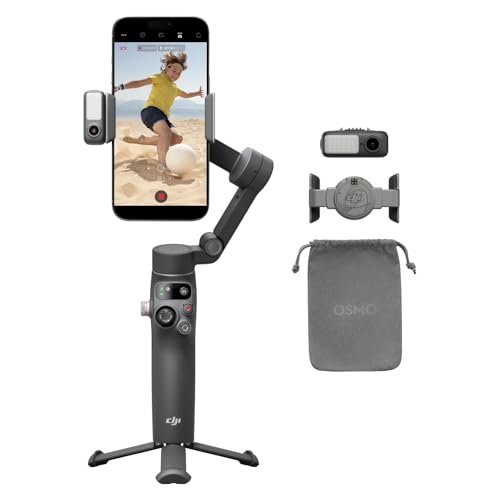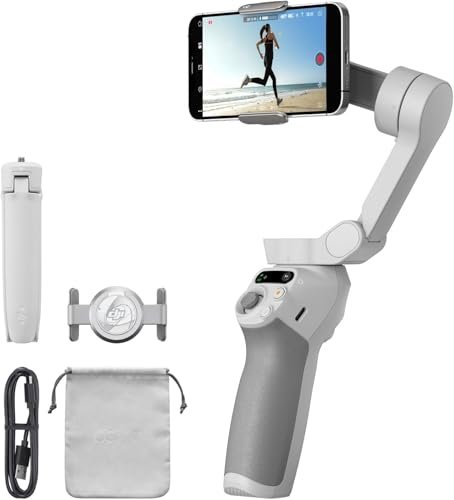So, you’ve got your hands on the fantastic Sony a6600, a truly powerful mirrorless camera known for its incredible autofocus, excellent low-light performance, and compact size. But let’s be real: handheld footage, no matter how steady you think you are, often looks shaky and unprofessional. That’s where a good gimbal comes in, transforming your wobbly shots into buttery-smooth cinematic masterpieces. If you’re searching for the best gimbal for Sony a6600, you’re in the right place!
Choosing the perfect camera stabilizer can feel a bit overwhelming with all the options out there. You need something that can handle the a6600’s weight, offers reliable stabilization, and is easy to use on the go. We’ve dug deep to find the top contenders that pair seamlessly with your Sony a6600, ensuring your videos look crisp, clear, and incredibly stable.
Let’s dive into our top picks for the best gimbal for Sony a6600 to help you elevate your videography game!
1. DJI RS 3 Mini, 3-Axis Gimbal Stabilizer for Cameras

The DJI RS 3 Mini is a game-changer for content creators who need professional-grade stabilization without the bulk. Designed to be incredibly lightweight and portable, this 3-axis gimbal stabilizer is perfect for run-and-gun shooting with your Sony a6600. Don’t let its mini size fool you; it packs a punch with powerful motors and DJI’s renowned 3rd-Gen RS Stabilization Algorithm, ensuring your footage is always smooth, even in challenging conditions. Its intuitive touchscreen and native vertical shooting capabilities make it a dream for social media creators.
Key Features:
– 795g (1.75lbs) Lightweight and Portable
– Load capacity of up to 2 kg (4.4 lbs)
– Bluetooth Shutter Control for easy camera operation
– 3rd-Gen RS Stabilization Algorithm for pro-level stability
– Native Vertical Shooting for social media content
– 1.4″ Full-Color Touchscreen with intuitive UI
– Requires DJI Ronin app for activation and full functionality
Pros:
– Extremely portable and comfortable for extended shoots
– Excellent stabilization performance for its size
– Quick and easy setup for vertical shooting
– Responsive touchscreen simplifies controls
– Strong payload capacity for a mini gimbal
Cons:
– Requires app activation for full features
– Might be slightly less robust than larger gimbals for heavier setups (though perfectly fine for a6600)
– Limited physical controls compared to larger RS models
User Impressions: Users frequently praise the RS 3 Mini for its incredible portability and surprisingly powerful stabilization. Many highlight how easy it is to balance and use right out of the box, making it a favorite for vloggers and travelers. The vertical shooting mode is a huge plus for those focused on TikTok or Instagram Reels.
2. ZHIYUN CINEPEER WEEBILL 3E 3-Axis Gimbal Stabilizer

The ZHIYUN CINEPEER WEEBILL 3E is another strong contender for the best gimbal for Sony a6600, offering a fantastic blend of portability and robust performance. Weighing in at just 1.05 kg (about A4 paper size), it’s designed for comfort during long shooting sessions with an ergonomic handle. It boasts a solid 3 kg (6.6 lbs) payload, easily handling your a6600 with various lenses. What truly makes the Weebill 3E stand out is its clever native vertical shooting system and impressive 16-hour battery life, ensuring you’re ready for all-day shoots.
Key Features:
– 1.05 kg (A4-sized) Lightweight and Portable
– 3 kg (6.6 lbs) Payload capacity
– Native Vertical Shooting with quick-mount system
– Bluetooth Shutter Control for wireless camera operation
– 16H Max Battery Life with 14W PD fast charging (2h 46m charge time)
– Comfortable handle design for reduced fatigue
– 2.5 Sling Mode compatible (requires separate accessories for wrist rest/sling handle)
– Note: Panasonic control cable included; Sony/Canon cables need separate purchase.
Pros:
– Excellent battery life for extended shooting
– Very portable without sacrificing payload
– Ergonomic design reduces hand fatigue
– Seamless native vertical shooting
– Fast charging capability
Cons:
– Some accessories for Sling Mode (like the wrist rest) are sold separately
– Specific camera control cables (e.g., for Sony) need to be purchased separately
– The “paper-based manuals” feature is a bit unusual to list as a primary benefit in 2024.
User Impressions: Many users appreciate the Weebill 3E’s lightweight build combined with its solid payload, making it a versatile choice. The extended battery life is a consistent favorite feature, enabling creators to shoot all day without worrying about power. The integrated vertical shooting mode also receives high marks for convenience.
3. FeiyuTech SCORP-C [Official] Camera Stabilizer 3-Axis
![FeiyuTech SCORP-C [Official] Camera Stabilizer 3-Axis...](https://m.media-amazon.com/images/I/41cuk84JumL._SL500_.jpg)
The FeiyuTech SCORP-C is an evolution in camera stabilization, offering an upgraded payload capacity and an integrated handle grip that sets it apart. Designed to be compatible with a wide range of mirrorless and DSLR cameras, including your Sony a6600, it can support up to 5.51 lbs. This robust capacity means you can mount heavier lenses or accessories without a hitch. Its multi-functional knob ring provides intuitive control over both camera focus and gimbal axes, streamlining your workflow and allowing you to capture dynamic shots with ease.
Key Features:
– Compatible with mainstream mirrorless and DSLR cameras, including Sony a6600
– Upgraded payload capacity of up to 5.51 lbs
– Integrated handle grip design
– Multi-Functional Knob Ring for camera focus and gimbal axis control
– Specific compatibility listed for Sony Alpha series (a6100, a6300, a6400, a6500, a6600, etc.)
Pros:
– High payload capacity allows for versatile lens choices
– Integrated handle grip enhances ergonomics and stability
– Multi-functional knob offers precise control
– Wide camera compatibility, including many Sony models
– Robust and durable build quality
Cons:
– Might be slightly heavier than mini gimbals due to its higher payload
– Potentially a steeper learning curve for beginners due to advanced features
– Could be overkill if you only ever use very light setups
User Impressions: Users commend the FeiyuTech SCORP-C for its solid build and impressive payload, which provides peace of mind when using larger lenses. The integrated grip and intuitive controls via the knob are often cited as excellent design choices, making complex shots feel more accessible. It’s frequently recommended for filmmakers looking for a reliable and versatile camera stabilizer.
What to Look For in the Best Gimbal for Sony A6600
Choosing the right gimbal isn’t just about picking the most popular one; it’s about finding the perfect match for your shooting style and your Sony a6600. Here’s a quick buying guide:
- Payload Capacity: This is crucial. Your gimbal needs to comfortably support the weight of your Sony a6600 plus your heaviest lens and any accessories (mic, monitor, etc.). Always check the gimbal’s max payload and compare it to your total setup weight.
- Portability & Weight: Are you a run-and-gun shooter or someone who sets up in one spot? Lighter, more compact gimbals like the DJI RS 3 Mini are great for travel and vlogging, while slightly heavier options might offer more stability for cinema lenses.
- Battery Life: Longer battery life means less downtime for charging. Look for gimbals that can last through your shooting sessions, ideally with fast-charging capabilities.
- Ease of Use & Balancing: A gimbal shouldn’t be a puzzle. Look for quick-release plates, intuitive controls (like touchscreens or multi-functional knobs), and straightforward balancing processes. Some gimbals even have auto-tune features.
- Stabilization Performance: This is the core function! Read reviews and watch footage samples. Look for gimbals with advanced stabilization algorithms that can handle various movements like panning, tilting, and walking.
- Features for Your Workflow:
- Native Vertical Shooting: Essential for social media content.
- Bluetooth Shutter Control: Allows you to start/stop recording or take photos directly from the gimbal.
- Accessory Mounts: For attaching lights, microphones, or external monitors.
- App Integration: A good companion app can unlock advanced features like time-lapse, panorama, and tracking modes.
Conclusion
Picking the best gimbal for Sony a6600 boils down to your specific needs, but you can’t go wrong with any of our top picks. The DJI RS 3 Mini excels in portability and ease of use, perfect for the on-the-go creator. The ZHIYUN CINEPEER WEEBILL 3E offers an incredible balance of payload, battery life, and ergonomic design. And the FeiyuTech SCORP-C stands out with its high payload and integrated handle, making it a robust choice for versatile setups.
No matter which one you choose, investing in a quality gimbal will dramatically improve the professional look and feel of your Sony a6600 footage. Get ready to capture some seriously smooth and stunning videos!
FAQ Section
Q1: Why do I need a gimbal for my Sony a6600?
A1: While the Sony a6600 has built-in image stabilization (IBIS), a 3-axis gimbal provides far superior stabilization, eliminating shakes and jitters from walking, running, or complex camera movements. This results in incredibly smooth, cinematic footage, essential for professional-looking videos, vlogs, and short films.
Q2: What is “payload capacity” and why is it important for a gimbal?
A2: Payload capacity refers to the maximum weight a gimbal can effectively stabilize. It’s crucial because your gimbal needs to support the combined weight of your Sony a6600, your heaviest lens, and any accessories (like external microphones, monitors, or batteries) you might attach. Exceeding the payload can lead to poor stabilization, motor strain, and potential damage to the gimbal.
Q3: Can I use any gimbal with my Sony a6600?
A3: Not necessarily. While many gimbals are designed for mirrorless cameras, you need to check two main things: 1) The gimbal’s payload capacity must be sufficient for your a6600 setup. 2) The gimbal must offer control compatibility with Sony cameras, often through specific control cables or Bluetooth integration, allowing you to control recording or focus directly from the gimbal.
Q4: What’s the difference between 3-axis stabilization and in-body image stabilization (IBIS)?
A4: IBIS (like in the a6600) stabilizes the camera sensor itself, primarily compensating for small shakes. A 3-axis gimbal, however, uses motors to physically move the camera along its roll, pitch, and yaw axes, actively counteracting larger movements, twists, and bumps from your hands or movement, providing much more comprehensive and fluid stabilization.
Q5: Is a lighter gimbal better for the Sony a6600?
A5: It depends on your usage. Lighter gimbals are fantastic for portability, vlogging, and extended handheld shooting without fatigue. However, they might have lower payload capacities. If you plan to use heavy lenses or many accessories, a slightly heavier gimbal with a higher payload might be more stable and versatile, even if it adds a bit more to your gear bag.
Q6: What is “Native Vertical Shooting” on a gimbal?
A6: Native vertical shooting means the gimbal is designed to quickly and easily switch your camera to a portrait orientation without needing additional cumbersome accessories or rebalancing. This is incredibly useful for creating content specifically for social media platforms like TikTok, Instagram Reels, or YouTube Shorts, which are optimized for vertical video.
Q7: How important is battery life for a gimbal?
A7: Very important! A long battery life ensures you can shoot for extended periods without interruption, especially during full-day events, travel, or remote shoots where charging might not be readily available. Look for gimbals with 10+ hours of battery life and fast-charging capabilities for maximum convenience.


